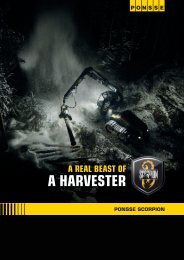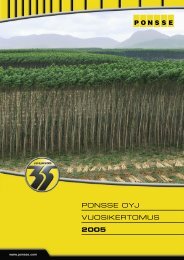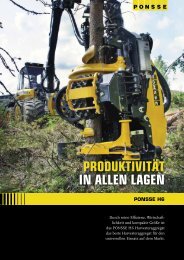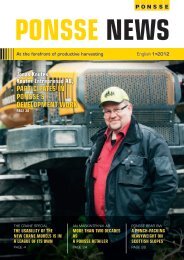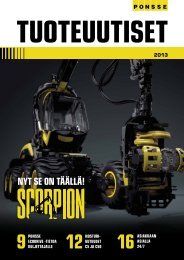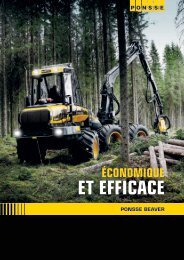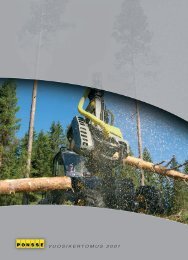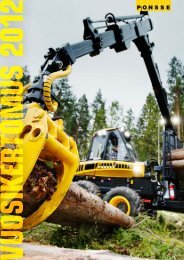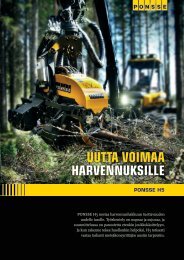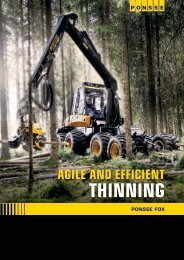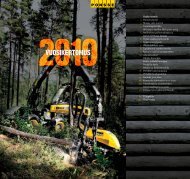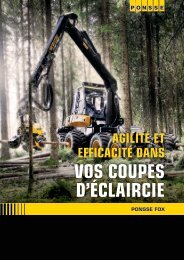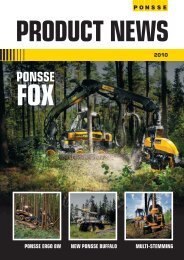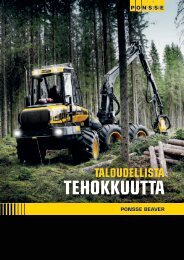PONSSE News 1/2011 ENG In English
PONSSE News 1/2011 ENG In English
PONSSE News 1/2011 ENG In English
- No tags were found...
You also want an ePaper? Increase the reach of your titles
YUMPU automatically turns print PDFs into web optimized ePapers that Google loves.
THe foresT worldSkillEd WOrkErS arE alWayS iN dEmaNd"It has been my experience that the forest machine industryhas a constant shortage of professional workforce, particularlyoperators with a genuine commitment to their job. We do havequalified people, but better salaries in the mining, earth-movingand transportation sectors are naturally attractive," says TeemuAalto, who has headed the Yli-Ii-based Metsä Aalto Oy for thepast 15 years.According to Aalto, it would only be fair to beable to pay harvester operators a competitivesalary, more in line with the substantial demandsand responsibilities of the job. A callingis of course a terrific thing when choosinga vocation, but the pay plays an equally importantrole when it comes to job satisfactionand commitment. According to Teemu, themachines are so comfortable and ergonomicthat the industry's attractiveness needs to beincreased with other means.Kone Aalto Oy, which harvests and forwardstimber in two chains primarily for StoraEnso in the Oulu region, is a partner in HarvestLogistic Oy, comprising several companies.The cooperative enterprise, which completedone year of operations in the spring of<strong>2011</strong>, has received only positive feedback fromtimber companies and participating contractors."An idea that one has been entertainingalone has often undergone an exciting refinementwhen discussed in the board meetingsof Harvest Logistic Oy. Having more mindsthan one to come up with ideas and thinkabout targets of development often proves tobe a lot more productive," remarks a satisfiedTeemu Aalto.Teemu's career in forestry was no accident.His father Pentti founded the companyback in 1965. <strong>In</strong> the beginning, the companybarked logs for pulp and paper mills. Thefirst forest machine was bought during thefirst half of the 1970s. Harvesting heads wereadopted in 1992. Once Teemu took over thereins in the mid-1990s, the company formwas changed from a partnership to a limitedliability company and the company adoptedits current name.About 90 per cent of Metsä Aalto's loggingsites consist of thinning stands. The annualstacking speed amounts to roughly 60,000solid cubic metres. The valuable machines cutgreen gold primarily in two shifts."The advanced technology of forest machinesis one serious matter. One has to participatein courses and training to be able tooptimise the benefits to be gained from themachines. When studying things with an activeapproach, they tend to stick as well," saysTeemu Aalto.Minor maintenance of the machines istaken care of by the company, but warrantyservices and any possible overhauls are performedby the contractual service partner operatingin Pudasjärvi. Replacement comesup once a machine has accumulated some10,000–15,000 hours of use. This means thatMetsä Aalto rarely employs machines morethan five years old."From the forest machine contractor's perspectivethe situation looks promising. Therehas been a good number of sites and cooperationwith all parties is working well. Withregard to operational development, the prevalentmood seems to be one characterised bya spirit of cooperation," says the 36-year-oldTeemu Aalto.a PlEaSaNT accidENTPauli Pöllänen, who has earned his living as aforest machine operator for a good 20 years,says he wound up in the business somewhataccidentally. When attending a dredgercourse, he was offered a job as a forwarderoperator."It was indeed something of a coincidencethat I started driving a forwarder in 1989. Butafter I completed my military service, I reallydidn't think twice about returning to the worldof men and machines," says Pauli Pöllänen.He says he has been interested in machinesever since he was a small boy. PauliPöllänen is one of the fifteen professionals ofJP Metsäkoneurakointi Oy. When includingpart-time contractors, this leading harvestingcompany in the region of Southern Ostrobothniaworks with the strength of morethan 30 machines.<strong>In</strong> 1997, Pauli switched the cabin of a forwarderto that of a harvester. Ever since then,he has cleared and thinned the forests ofSouthern Ostrobothnia. The harvesters cutwood at a rate of roughly 30,000 cubic metresa year. The hours pile up at a reasonable rateas well, since the 2007 <strong>PONSSE</strong> Beaver operatedby Pauli has already accumulated 8,500hours of use."Not that these woods were as sturdy as theones in Eastern Finland, but I have had the opportunityto cut down a tree the size of 2,700litres. But in this region a tree would quicklybe furnished with a conservation band if itwould top 3,000 litres," says Pauli Pöllänen.Thinning accounts for the better part offifty per cent of the harvesting and especiallymulti-stemming, or thinning performed witha fuel-wood grapple, has increased considerablyduring the past few years. The biofuelpower plant in Jakobstad is one of the mostimportant delivery points for the energy wood.When asked about the positive aspects of aharvester operator's job, Pauli responds withouthesitation that the independence is one ofthe essential features that increase job satisfaction.When harvesting, the operator mustmake independent decisions all the time. Thesuccess of such decisions is measured by boththe forest owner and the representative of thebuying company. According to Pauli, a professionallyand carefully performed job has beensufficient so far, and that the operator doesnot spend much time thinking about his rolebetween the seller and the buyer.Although the company's machines primarilycut wood in two shifts, Pauli Pöllänendoes not perceive this as particularly taxing.The morning shift begins at six and the eveningshift ends around midnight. Luckily, shiftscan be switched between operators, a factwhich alleviates the drawbacks of shift work.According to Pauli, work in the cabin of aforest machine constitutes the best possibleinstruction and accumulation of skills. Naturally,more in-depth orientation is necessaryin relation to new machines. This kind oftraining has been managed in an exemplaryfashion by the company together with the machinemanufacturer."This is a nice and challenging job, nocomplaints there. But sometimes I get thefeeling that the parties offering forest machineinstruction glorify the job a little toomuch. This might lead to some disappointments,particularly among younger students,"says Pauli Pöllänen.Ponsse <strong>News</strong> 1 • <strong>2011</strong> 33



